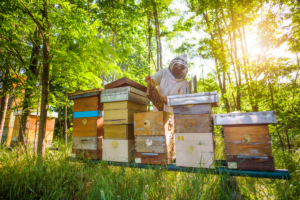Honey, a golden elixir cherished for its sweetness and health benefits, has been harvested and used by humans for thousands of years. However, the journey from hive to jar involves meticulous processes that ensure the honey remains pure, nutritious, and safe for consumption. Proper collection and storage of honey are critical not only to maintain its quality but also to preserve its natural properties and extend its shelf life. Understanding the importance of these practices is essential for beekeepers, both novice and experienced, who aim to produce high-quality honey.
The process begins with the careful collection of honey from the hives. This step is crucial because improper handling can introduce contaminants, spoil the honey, and even harm the bees. Ensuring that the honey is collected in a clean, controlled manner helps maintain its natural purity and prevents the introduction of unwanted substances. Furthermore, proper collection techniques can enhance the efficiency of the harvest, reduce waste, and protect the health of the bee colony.
Once harvested, the next significant step is the storage of honey. Honey is a hygroscopic substance, meaning it can absorb moisture from its surroundings. If not stored correctly, this characteristic can lead to fermentation and spoilage. Appropriate storage conditions, such as using airtight containers and maintaining optimal temperature and humidity levels, are vital to preserving honey’s quality. Additionally, well-stored honey retains its flavor, aroma, and nutritional benefits over time.
Benefits of Safe and Efficient Practices
Adopting safe and efficient practices in honey collection and storage brings numerous benefits. For one, it ensures the production of high-quality honey that is free from impurities and retains its natural goodness. This high-quality honey is not only more enjoyable for consumers but also fetches a better price in the market, benefiting the beekeeper economically.
Moreover, following proper procedures promotes sustainability in beekeeping. Healthy bee colonies are essential for pollination and biodiversity, and responsible honey collection methods support the well-being of these vital insects. By minimizing stress and disturbance to the bees during the collection process, beekeepers contribute to the long-term health and productivity of their hives.
Efficient practices also mean less waste and more yield. By optimizing the extraction and storage processes, beekeepers can maximize the amount of honey they harvest, ensuring that more of the hard-earned nectar from their bees is collected and preserved. This efficiency translates into better resource management and higher overall productivity.
In summary, the importance of proper honey collection and storage cannot be overstated. These practices are fundamental to producing honey that is pure, flavorful, and nutritious. They also support sustainable beekeeping and maximize the yield and profitability of the harvest. As we delve deeper into the techniques and strategies for collecting and storing honey, it becomes clear that investing time and effort into these processes pays off significantly in terms of both quality and quantity.
Preparation for Honey Collection
Choosing the Right Time for Harvest
The timing of honey harvest is crucial for ensuring the quality and quantity of honey. The best time to collect honey is when the frames are at least 80% capped, meaning the bees have sealed the honeycomb cells with a wax cap. This indicates that the honey is mature and has the right moisture content, typically below 18%, preventing fermentation. Seasonal factors also play a role; late spring to early summer is often ideal, as bees have had ample time to collect nectar and convert it into honey.
Essential Equipment for Collection
To collect honey efficiently and safely, beekeepers need a variety of tools. These include:
– **Bee Suit and Gloves:** Essential for protection against stings.
– **Hive Tool:** Used to pry apart frames and remove propolis.
– **Smoker:** Helps to calm the bees, making the extraction process smoother.
– **Bee Brush:** Gently removes bees from the frames.
– **Uncapping Knife or Fork:** Used to remove the wax caps from the honeycomb cells.
– **Honey Extractor:** A centrifugal device that extracts honey from the frames.
– **Strainers and Filters:** To remove wax and other debris from the honey.
Preparing the Hives
Before beginning the harvest, it is important to prepare the hives properly. This includes:
– **Inspecting the Hive:** Check for signs of disease or pests and ensure the colony is healthy.
– **Providing Space:** Adding extra supers (honey storage boxes) if needed to give the bees space to store more honey.
– **Setting Up a Harvest Area:** Ensure you have a clean, designated area for processing the honey.
Honey Collection Techniques
Traditional Methods of Collection
Traditional honey collection methods involve manual extraction and are often employed by small-scale beekeepers. These methods include:
– **Crush and Strain:** Involves crushing the honeycomb and straining the mixture to separate honey from wax.
– **Top Bar Hives:** Honey is harvested by cutting the comb from the top bars, which is then processed manually.
Using Smokers and Other Tools
Smokers are an essential tool for calming bees during honey collection. Smoke masks the alarm pheromones released by guard bees, reducing the likelihood of aggressive behavior. In addition to smokers, beekeepers use hive tools to pry open hive components and brushes to gently remove bees from the frames.
Handling Bees with Care
When collecting honey, it is important to handle bees gently to minimize stress and avoid harming them. Moving slowly, wearing protective gear, and using a smoker can help manage the bees effectively. Always ensure that the queen is not disturbed during the process, as her well-being is critical to the hive’s health.
Honey Extraction Process
Removing Honeycombs
To begin the extraction process, remove the honey-filled frames from the hive. This is done by carefully lifting the frames, ensuring minimal disturbance to the bees. Once the frames are removed, they should be taken to a clean area for extraction.
Manual and Mechanical Extraction Techniques
There are two primary methods for extracting honey from the combs:
– **Manual Extraction:** This involves using an uncapping knife or fork to remove the wax cappings from the cells and then allowing the honey to drain out.
– **Mechanical Extraction:** Honey extractors use centrifugal force to spin the frames, causing the honey to be flung out of the comb. Extractors come in various sizes and can be hand-cranked or electric.
Filtering and Cleaning the Honey
After extraction, the honey needs to be filtered to remove impurities such as wax particles and bee parts. This is typically done using strainers and fine mesh filters. Ensuring that the honey is clean and pure is crucial for quality and shelf life.
Proper Storage of Honey
Types of Storage Containers
Choosing the right containers for storing honey is essential to maintain its quality. Suitable options include:
– **Glass Jars:** Non-reactive and provide an airtight seal.
– **Plastic Containers:** Lightweight and shatterproof, but should be food-grade.
– **Stainless Steel Drums:** Ideal for large quantities, offering durability and protection against contamination.
Ideal Storage Conditions
Honey should be stored in a cool, dry place away from direct sunlight. The ideal temperature for honey storage is between 50-70°F (10-21°C). High temperatures can cause honey to darken and lose its flavor, while cold temperatures can lead to crystallization.
Preventing Honey Crystallization
Crystallization is a natural process where honey turns from a liquid to a semi-solid state. To prevent this:
– **Store at Consistent Temperatures:** Avoid fluctuating temperatures that can accelerate crystallization.
– **Use Airtight Containers:** Prevents moisture absorption, which can lead to crystallization.
– **Gently Warm Crystallized Honey:** Place the container in warm water (not exceeding 104°F or 40°C) to re-liquefy.
Maintenance and Quality Inspection
Regular Inspection of Stored Honey
Regularly inspect stored honey for signs of spoilage or fermentation. Properly stored honey can last indefinitely, but it is important to check for:
– **Changes in Color or Smell:** These can indicate spoilage.
– **Presence of Foam or Bubbles:** Signs of fermentation.
Identifying and Correcting Common Problems
If issues are detected, address them promptly. For example, if honey has absorbed moisture and begun to ferment, it can often be reprocessed and dehumidified to restore quality.
Purity and Quality Tests
Conducting periodic tests to ensure the purity and quality of the honey is beneficial. This can involve:
– **Moisture Content Testing:** Using a refractometer to ensure levels are below 18%.
– **Taste and Aroma Checks:** Ensuring the honey retains its characteristic flavor and scent.
Safety and Hygiene in Collection and Storage
Hygiene Practices During Collection and Extraction
Maintaining high standards of hygiene is crucial throughout the collection and extraction process. This includes:
– **Sanitizing Equipment:** Regularly clean and sanitize all tools and equipment.
– **Clean Work Area:** Ensure the area where honey is processed is free from contaminants.
– **Personal Hygiene:** Beekeepers should wash hands thoroughly and wear clean protective clothing.
Safety Measures to Avoid Accidents
Safety measures are essential to protect both the beekeeper and the bees:
– **Proper Use of Tools:** Follow instructions and guidelines for using equipment like extractors and smokers.
– **Protective Gear:** Always wear protective clothing to avoid stings.
– **First Aid:** Have a first aid kit on hand to address any bee stings or injuries.
Importance of a Clean and Safe Environment
A clean and safe environment is paramount to ensure the quality of the honey and the safety of the beekeepers. This includes:
– **Pest Control:** Regularly check for and address any pest issues in the storage area.
– **Ventilation:** Ensure proper ventilation to prevent moisture build-up.
– **Cleanliness:** Keep the storage and processing areas clean and organized.
Common Problems and Solutions
Dealing with Pests and Diseases in Hives
Pests and diseases can severely impact honey production. Common issues include:
– **Varroa Mites:** Regularly treat hives with approved mite treatments.
– **Wax Moths:** Keep hives strong and healthy to prevent infestations.
– **American Foulbrood:** Monitor for symptoms and apply appropriate treatments.
Solutions for Fermented or Contaminated Honey
If honey ferments or becomes contaminated, steps to salvage it include:
– **Reprocessing:** Gently heat and filter the honey to remove contaminants.
– **Moisture Reduction:** Use a dehumidifier to reduce moisture content.
Strategies to Minimize Losses
To minimize losses and maximize yield:
– **Regular Hive Inspections:** Early detection of issues allows for timely intervention.
– **Proper Storage Techniques:** Follow best practices to prevent spoilage and contamination.
– **Efficient Harvesting:** Use effective methods to ensure maximum extraction with minimal waste.
Benefits of Well-Collected and Stored Honey
Nutritional and Medicinal Properties of Pure Honey
Well-collected and stored honey retains its natural nutritional and medicinal properties, including:
– **Antioxidants:** Honey is rich in antioxidants that help protect the body from oxidative stress.
– **Antibacterial Properties:** Natural honey has antibacterial effects that can help heal wounds and prevent infections.
– **Nutritional Value:** Honey contains vitamins, minerals, and enzymes that contribute to overall health.
Impact on Honey Quality and Flavor
Proper collection and storage techniques preserve the unique flavor and aroma profiles of different honey varieties. This ensures that consumers enjoy the full sensory experience of high-quality honey.
Commercial Advantages of High-Quality Honey
High-quality honey commands a premium price in the market, providing economic benefits to beekeepers. Additionally, maintaining high standards enhances the reputation of beekeeping operations, leading to increased demand and customer loyalty.
Summary of Key Points
In this comprehensive guide, we have explored the critical aspects of collecting and storing honey safely and efficiently. From choosing the right time for harvest and preparing your hives to utilizing the best techniques for extraction and ensuring proper storage, each step plays a vital role in maintaining the quality and safety of the honey. We have also discussed the importance of regular maintenance and quality checks, as well as the need for strict hygiene and safety practices. Additionally, understanding and addressing common problems, such as pest infestations and honey crystallization, are crucial for successful honey production.
Importance of Following Good Practices in Collection and Storage
Adhering to good practices in honey collection and storage is essential for several reasons. Firstly, it ensures that the honey retains its natural nutritional and medicinal properties, offering maximum health benefits to consumers. Secondly, maintaining high standards of hygiene and safety protects both the beekeeper and the bees, fostering a healthy and productive apiary. Furthermore, proper storage techniques help prevent spoilage and extend the shelf life of honey, making it a reliable and valuable product. Overall, following these best practices contributes to producing honey of the highest quality, enhancing its flavor, aroma, and market value.
Encouragement for Beekeepers to Adopt Safe and Efficient Methods
For beekeepers, adopting safe and efficient methods in honey collection and storage is not just about preserving the quality of their product but also about ensuring the sustainability and success of their beekeeping operations. By implementing the techniques and practices discussed in this guide, beekeepers can maximize their honey yield, minimize losses, and protect their colonies from diseases and pests. Additionally, producing high-quality honey can lead to greater customer satisfaction and increased demand, providing significant economic benefits. As the global demand for pure, natural honey continues to grow, beekeepers who prioritize safe and efficient practices will be well-positioned to thrive in the market. Embrace these methods to ensure the health of your bees, the quality of your honey, and the success of your beekeeping endeavors.

Hi, I’m James Stevan, an avid beekeeper with over a decade of experience in apiculture. My passion for bees drives me to share practical tips and insights on sustainable beekeeping. Join me as we explore the fascinating world of bees and their crucial role in our ecosystem.




